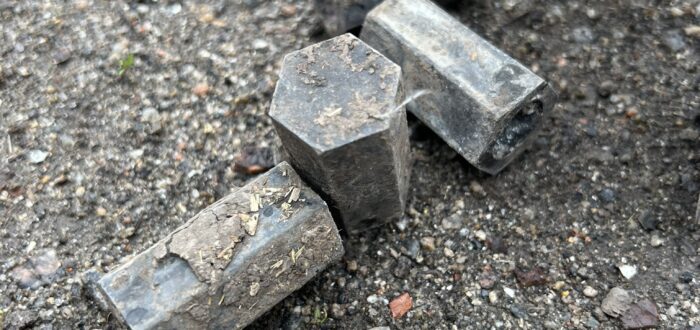N.R. Jenzen-Jones
Editor’s Note: This article draws, in part, on a previous ARES article examining the use of the 9M22S incendiary rocket in eastern Ukraine in 2014.
Images shared by ABC News foreign correspondent James Longman via social media earlier today (19 April 2022) show the remnants of 9M22S or 9M28S 122 mm incendiary rockets (see Figure 1), documented in the village of Novoiakovlivka, near the city of Zaporizhzhia in south-eastern Ukraine. These were likely fired by the 9K51 Grad (Град; ‘Hail’) or upgraded 9K51M Tornado-G (Торнадо-Г; ‘Tornado-G’) multiple-barrel rocket launchers (MBRL). Earlier videos, also shared via social media, show incendiary weapons functioning during the night time, the visual signatures of which are consistent with 9M22S rockets. One example was recorded on 12 March 2022 near the town of Popasna, Luhansk Oblast, in eastern Ukraine (see Figure 2). ARES decided to wait for publicly shared imagery of remnants from this model of munition to become available before posting this article. The 9M22S remains in Russian service, and was previously documented by ARES during the Ukraine conflict in 2014.


The 9M22S 122 mm incendiary rocket was developed by the Splav State Research and Production Association in 1971, and was broadly based on the 9M22 high explosive fragmentation (HE-FRAG) munition which preceded it. In place of the 9M22 rocket’s HE-FRAG warhead, the 9M22S (or the shorter 9M28S) carries the 9N510 warhead, which contains 180 individual incendiary elements (see Figure 3). Designed to start fires in vegetated areas such as forests, amongst ammunition or fuel storage sites, and elsewhere, these incendiary elements consist of hexagonal prisms made of a magnesium alloy known as ML-5, filled with a pyrotechnic composition similar to thermite. Each element is nominally 40 mm long and 25 mm wide, and has a burn time of at least 2 minutes. The incendiary elements are packed into the body of the rocket in 9 layers of 18 elements per layer, with a further 18 elements arranged in three layers in the conical nose of the munition. After the rocket is fired, a time fuze (most often the GDT-90, although the TM-120 has also been observed in use with these munitions) fuze arms and functions the munition after the selected delay. When the munition functions, the individual elements are ignited by way of a black powder expelling and ignition charge, and scattered over an area of approximately 80 × 80 metres (6,400 square metres).

Despite some reporting to the contrary, the 9M22S does not deliver a white phosphorus payload. In fact, white phosphorus—whilst available in ‘unitary’ format munitions for incendiary use and sometimes used as an ignition source in some incendiary munitions due to its pyrophoric characteristics, is most often used for marking and screening purposes, dues to the large volume of dense, white smoke it can quickly produce. Magnesium- and thermite-based incendiary munitions, by contrast, are most often used to ignite fires in areas such as fuel depots, ammunition storage sites, and other flammable military targets. A Soviet manual for the 9M22S also specifically details the intended use of the weapon in areas of dry vegetation. Unfortunately, such munitions have also been used in Syria, Ukraine, and elsewhere in areas primarily or exclusively containing civilians and civilian objects.

The images from Novoiakovlivka show the characteristic ML-5 incendiary elements scattered on the ground. Whilst similar elements are used in a few different incendiary munitions, the physical characteristics of these examples, as well as the remnant sheet metal pictured in immediate proximity (including the colour, markings, and thickness of the sheet metal), make it highly likely that the 9M22S rocket was employed in this case (see Figure 4). A further photo shows a characteristic residue left by the burnt thermite and magnesium compounds of the incendiary elements used in the 9M22S (see Figure 5).

Technical Specifications
9M22S incendiary rocket
Calibre: 122 mm
Maximum range: 19.9 km
Length: 2,970 mm
Total weight: 65.6 kg
Warhead weight: 17.8 kg
Fuze: impact or time fuze (typically GDT-90)
Fuze weight: 0.95 kg (GDT-90)
Number of incendiary elements: 180
Total weight of incendiary elements: 5.94 kg
Special thanks to James Longman of ABC News for sharing information and images.
Sources
ARES (Armament Research Services). n.d. Conflict Materiel (CONMAT) Database. Confidential. Perth: ARES.
Gurov, S.V. n.d. ‘Неуправляемый реактивный снаряд МЗ-21 (9М22С)’ [‘Unguided missile MZ-21 (9M22S)’]. Missilery.info. <https://missilery.info/missile/grad/m3-21>.
Lyamin, Yuri & Michael Smallwood. 2014. ‘9M22S incendiary rocket components documented in eastern Ukraine’. The Hoplite. 14 October. <http://armamentresearch.com/9m22s-incendiary-rocket-components-documented-in-eastern-ukraine/>.
Soviet Ministry of Defence. 1972. РЕАКТИВНЫЙ ЗАЖИГАТЕЛЬНЫЙ СНАРЯД М-21 (ИНДЕКС 9М22C) [‘M21 Incendiary Rockets (Index 9M22S)’]. Moscow: Ministry of Defence of the USSR.
Ukrainian Military Center. 2022. ‘Not phosphorus: Russia uses 9M22S incendiary projectiles in Ukraine’. Ukrainian Military Center. 27 March. <https://mil.in.ua/en/articles/not-phosphorus-russia-uses-9m22s-incendiary-projectiles-in-ukraine/>.
Remember, all arms and munitions are dangerous. Treat all firearms as if they are loaded, and all munitions as if they are live, until you have personally confirmed otherwise. If you do not have specialist knowledge, never assume that arms or munitions are safe to handle until they have been inspected by a subject matter specialist. You should not approach, handle, move, operate, or modify arms and munitions unless explicitly trained to do so. If you encounter any unexploded ordnance (UXO) or explosive remnants of war (ERW), always remember the ‘ARMS’ acronym:
AVOID the area
RECORD all relevant information
MARK the area from a safe distance to warn others
SEEK assistance from the relevant authorities

